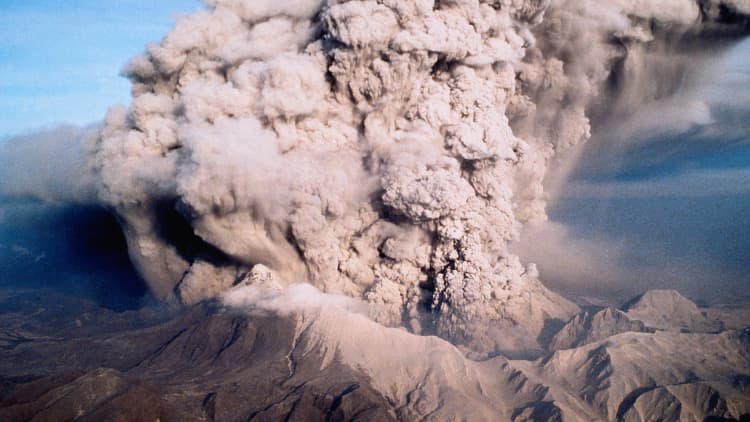The United Nations Environment Program, the world’s leading voice on the environment, said in late February that far more research into the risks and benefits of SRM would be required before there can be any consideration for its potential deployment.
David Gannon | Afp | Getty Images
Billionaires including Bill Gates, George Soros and Facebook co-founder Dustin Moskovitz have all expressed interest in “solar geoengineering,” a deeply contentious idea that involves cooling the Earth by reflecting sunlight back into space.
There are growing calls to accelerate the research of solar radiation management (SRM), sometimes broadly referred to as solar geoengineering, particularly as the planet inches closer to exceeding the 1.5 degrees Celsius temperature limit.
This temperature threshold is widely recognized as critically important because so-called tipping points become more likely beyond this level. Tipping points are thresholds at which small changes can lead to dramatic shifts in Earth’s entire life support system.
Solar geoengineering, which has long been opposed by environmental campaign groups, has been thrust back into the climate policy discourse in recent months.
In late February, over 60 researchers from prominent institutions published a letter calling for more rigorous study of the strategy, as well as small-scale field experiments, while a U.N. report suggested the time had come to start investigating whether SRM could help to combat the climate crisis.
The White House, too, announced in October last year that it was pushing ahead with a five-year research plan to assess ways of modifying the amount of sunlight that reaches the Earth.
Hundreds of climate scientists, however, are firmly against proliferating calls for solar geoengineering research and its potential development.
They’ve warned in an open letter that the increasing normalization of SRM technologies as a possible climate fix is a cause for alarm — one that could have dangerous and unexpected consequences.
What is solar geoengineering?
Solar geoengineering or SRM refers to a speculative set of technologies designed to cool the Earth. Some of the techniques involved, such as spraying sulfur dioxide into the atmosphere, are known to have harmful effects on the environment and human health.
Nonetheless, some climate scientists who are concerned that humanity will overshoot its emissions targets say further research into SRM is important to figure out how best to balance these risks against a possibly catastrophic rise in the Earth’s temperature.
It is not mitigation. It is a very speculative set of proposed technological interventions into the atmosphere.
Lili Fuhr
Deputy director of the Center for International Environmental Law
The United Nations Environment Program, the world’s leading voice on the environment, said in late February that far more research into the risks and benefits of SRM would be required before there can be any consideration for its potential deployment.
UNEP confirmed SRM is not yet ready for large-scale deployment and highlighted there is no substitute for an urgent and massive reduction in greenhouse gas emissions, “which must remain the global priority.”
To be sure, researchers calling for the rigorous study of SRM are not endorsing solar geoengineering as a climate solution.
Arguments against pursuing further research into SRM have previously been outlined in a 2022 paper, however, which concludes that “solar geoengineering at planetary scale is not governable in a globally inclusive and just manner within the current international political system.”

The paper advocates for an International Non-Use Agreement on Solar Geoengineering, a call that has since received the backing of hundreds of climate scientists.
Lili Fuhr, deputy director of the Center for International Environmental Law, described solar radiation management or solar geoengineering as “the ultimate false solution.”
“It is not mitigation,” Fuhr said during a media briefing earlier this month. “It is a very speculative set of proposed technological interventions into the atmosphere.”
Fuhr highlighted that the U.N.’s Intergovernmental Panel on Climate Change had assessed the controversial technology but ultimately decided not to include it in the summary for policymakers in its latest report.
Instead, the world’s top climate scientists concluded “that we know way too little about it [and] it comes with novel risks and harms for ecosystems and people,” she added.
“I think the word geoengineering only appears about two times in the Working Group III report and it is only to say that we don’t use the term geoengineering,” IPCC Working Group III co-chair Jim Skea said during the same briefing.
“Many of our authors couldn’t bear to use the words solar radiation management and insisted on calling it solar radiation modification because of their distaste for it,” Skea said.
‘Dangerous distractions’
The IPCC Working Group III report, published in April last year, focused on climate change mitigation and assessed methods for reducing greenhouse gas emissions as well as removing greenhouse gases from the atmosphere.
Referring to Fuhr’s comments on solar geoengineering, Skea said, “You’re absolutely right, it is not mitigation and all of the scoped-in references to SRM in the three Working Group reports are scattered throughout the three Working Group reports with very different dimensions.”
“All that we were asked to do was to look at legal and ethical aspects which we actually did on our international chapter,” he added.
Harjeet Singh, head of global political strategy at Climate Action Network, which includes more than 1,500 civil society groups, said that all of the challenges related to SRM and solar geoengineering should be seen as “dangerous distractions.”
— CNBC’s Catherine Clifford contributed to this report.


